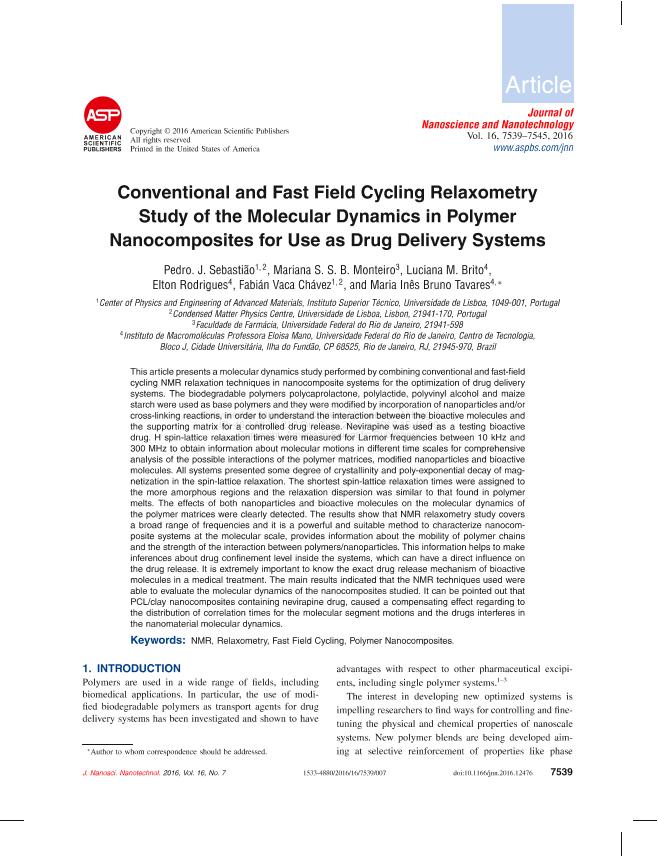Mostrar el registro sencillo del ítem
dc.contributor.author
Sebastião, Pedro J.
dc.contributor.author
Monteiro, Mariana S. S. B.
dc.contributor.author
Brito, Luciana M.
dc.contributor.author
Rodrigues, Elton
dc.contributor.author
Vaca Chávez Fornasero, Fabián

dc.contributor.author
Tavares, Maria Inês Bruno
dc.date.available
2023-01-30T18:35:08Z
dc.date.issued
2016-07
dc.identifier.citation
Sebastião, Pedro J.; Monteiro, Mariana S. S. B.; Brito, Luciana M.; Rodrigues, Elton; Vaca Chávez Fornasero, Fabián; et al.; Conventional and fast field cycling relaxometry study of the molecular dynamics in polymer nanocomposites for use as drug delivery systems; American Scientific Publishers; Journal of Nanoscience and Nanotechnology; 16; 7; 7-2016; 7539-7545
dc.identifier.issn
1533-4880
dc.identifier.uri
http://hdl.handle.net/11336/186180
dc.description.abstract
This article presents a molecular dynamics study performed by combining conventional and fast-field cycling NMR relaxation techniques in nanocomposite systems for the optimization of drug delivery systems. The biodegradable polymers polycaprolactone, polylactide, polyvinyl alcohol and maize starch were used as base polymers and they were modified by incorporation of nanoparticles and/or cross-linking reactions, in order to understand the interaction between the bioactive molecules and the supporting matrix for a controlled drug release. Nevirapine was used as a testing bioactive drug. H spin-lattice relaxation times were measured for Larmor frequencies between 10 kHz and 300 MHz to obtain information about molecular motions in different time scales for comprehensive analysis of the possible interactions of the polymer matrices, modified nanoparticles and bioactive molecules. All systems presented some degree of crystallinity and poly-exponential decay of magnetization in the spin-lattice relaxation. The shortest spin-lattice relaxation times were assigned to the more amorphous regions and the relaxation dispersion was similar to that found in polymer melts. The effects of both nanoparticles and bioactive molecules on the molecular dynamics of the polymer matrices were clearly detected. The results show that NMR relaxometry study covers a broad range of frequencies and it is a powerful and suitable method to characterize nanocomposite systems at the molecular scale, provides information about the mobility of polymer chains and the strength of the interaction between polymers/nanoparticles. This information helps to make inferences about drug confinement level inside the systems, which can have a direct influence on the drug release. It is extremely important to know the exact drug release mechanism of bioactive molecules in a medical treatment. The main results indicated that the NMR techniques used were able to evaluate the molecular dynamics of the nanocomposites studied. It can be pointed out that PCL/clay nanocomposites containing nevirapine drug, caused a compensating effect regarding to the distribution of correlation times for the molecular segment motions and the drugs interferes in the nanomaterial molecular dynamics.
dc.format
application/pdf
dc.language.iso
eng
dc.publisher
American Scientific Publishers

dc.rights
info:eu-repo/semantics/openAccess
dc.rights.uri
https://creativecommons.org/licenses/by-nc-sa/2.5/ar/
dc.subject
FAST FIELD CYCLING
dc.subject
NMR
dc.subject
POLYMER NANOCOMPOSITES
dc.subject
RELAXOMETRY
dc.subject.classification
Física de los Materiales Condensados

dc.subject.classification
Ciencias Físicas

dc.subject.classification
CIENCIAS NATURALES Y EXACTAS

dc.title
Conventional and fast field cycling relaxometry study of the molecular dynamics in polymer nanocomposites for use as drug delivery systems
dc.type
info:eu-repo/semantics/article
dc.type
info:ar-repo/semantics/artículo
dc.type
info:eu-repo/semantics/publishedVersion
dc.date.updated
2023-01-26T17:37:40Z
dc.identifier.eissn
1533-4899
dc.journal.volume
16
dc.journal.number
7
dc.journal.pagination
7539-7545
dc.journal.pais
Estados Unidos

dc.journal.ciudad
California
dc.description.fil
Fil: Sebastião, Pedro J.. Universidade de Lisboa; Portugal
dc.description.fil
Fil: Monteiro, Mariana S. S. B.. Universidade Federal do Rio de Janeiro; Brasil
dc.description.fil
Fil: Brito, Luciana M.. Universidade Federal do Rio de Janeiro; Brasil
dc.description.fil
Fil: Rodrigues, Elton. Universidade Federal do Rio de Janeiro; Brasil
dc.description.fil
Fil: Vaca Chávez Fornasero, Fabián. Universidade de Lisboa; Portugal. Universidad Nacional de Córdoba. Facultad de Matemática, Astronomía y Física; Argentina. Consejo Nacional de Investigaciones Científicas y Técnicas. Centro Científico Tecnológico Conicet - Córdoba. Instituto de Física Enrique Gaviola. Universidad Nacional de Córdoba. Instituto de Física Enrique Gaviola; Argentina
dc.description.fil
Fil: Tavares, Maria Inês Bruno. Universidade Federal do Rio de Janeiro; Brasil
dc.journal.title
Journal of Nanoscience and Nanotechnology

dc.relation.alternativeid
info:eu-repo/semantics/altIdentifier/url/https://www.ingentaconnect.com/content/asp/jnn/2016/00000016/00000007/art00131;jsessionid=1bslr8r0boflg.x-ic-live-01
dc.relation.alternativeid
info:eu-repo/semantics/altIdentifier/doi/http://dx.doi.org/10.1166/jnn.2016.12476
Archivos asociados
